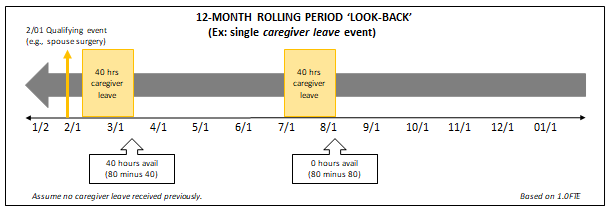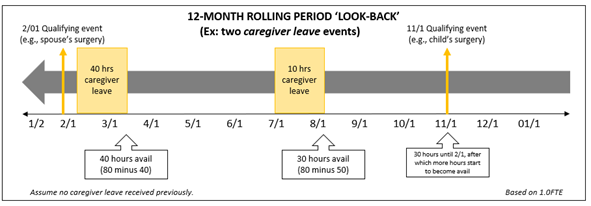1. How does the University define a year?
The year is defined as the 12 months measured backward from the date an employee uses a qualifying leave. With this "rolling" method, each time an employee uses caregiver leave, the remaining balance of the applicable leave which has not been used during the immediately preceding 12 months is the available leave. An example of how the new calculation method works is below: Example:

2. What happens if an employee has multiple qualifying events within 12-months?
Employees must apply for caregiver leave with each qualifying event. If the situation is approved as a caregiver leave qualifying event, the remaining balance of the applicable leave which has not been used during the immediately preceding 12 months is available leave. Example:

3. If an employee has a break-in-service, does the rolling period start over again to establish the available leave balance?
No. If an employee has a break in service, the caregiver leave used in the preceding 12 months, including before the break, counts towards the 12-month rolling period.
4. For whose illness can caregiver leave be used?
Caregiver leave may be used for immediate family members as defined in the University’s FMLA policy which indicates “for the employee’s spouse, son or daughter, parent, sponsored adult dependent, or the child of a sponsored adult dependent with a serious health condition, as certified by a health care provider.” See HR-407 FMLA. Son or daughter includes biological, adopted, or foster child; the child of a Sponsored Adult Dependent; a stepchild; a legal ward; or a child of a person standing in loco parentis. Additionally, the child must be under 18 or 18 years or older and "incapable of self-care because of mental or physical disability." Parent includes the biological parent of an employee or an individual who stands or stood in loco parentis to an employee when the employee was a child.
5. How is “serious health condition” defined for purposes of caregiver leave?
A serious health condition is defined according to the FMLA definition, including an illness, injury, impairment, or physical or mental condition that involves: Inpatient care, such as an overnight stay in a hospital, hospice, or residential medical care facility or any subsequent treatment in connection with such inpatient care, or continuing treatment by a health care provider. See HR-407 FMLA.
6. Can a supervisor deny caregiver leave?
Supervisors are responsible for ensuring appropriate staffing levels while supporting employees’ requests for time off. Employees are encouraged to work with their supervisor to plan for anticipated time off. If an employee meets the qualifications for caregiver leave pay, the approved time off will be eligible for pay pursuant to HR-422.
7. Does caregiver leave cover pre-existing conditions?
Yes. Pre-existing conditions which an employee’s immediate family member had before the University's caregiver leave pay became available or before the employee started employment with the University are eligible to be considered for caregiver leave pay. However, all other qualifying criteria remain applicable (i.e., the condition is considered a serious health condition, etc.).
8. What is the effect of a holiday and/or winter break pay when an employee is on leave?
Employees will receive holiday pay and winter break pay, if eligible, when on a paid leave of absence. In addition, caregiver leave hours available will not reduce when receiving holiday or winter break hours.
9. What is Annual Base Benefit Rate (ABBR)?
ABBR is the base rate of employees’ earnings (e.g., their hourly rate of pay). It includes income before pre-tax contributions are made to flexible spending accounts or deferred compensation plans. ABBR does not include other income received such as overtime pay, shift differentials, incentive payments, or employer contributions to retirement plans.
10. Are both caregiver leave and parental leave available to the non-birthing parent for the birth of a child?
Yes. The birth of a child is considered a qualifying event under both caregiver leave and parental leave. For caregiver leave, to care for the serious health condition of an immediate family member, the first six weeks after the birth of a child is typically considered a medical event qualifying for caregiver leave. Thus, the non-birthing parent may consider requesting both leaves to be used as follows: Example:

11. Is an employee eligible for caregiver leave even if they are not eligible for FMLA?
Yes. Eligibility for caregiver leave does not require an employee to be eligible for FMLA. While many of the policy elements are the same, an employee may be approved for caregiver leave even if they are not yet eligible for or have exhausted available leave under the Family and Medical Leave Act (FMLA).
Date Effective: Posted 10-01-2023 with an effective date of 01-01-2024
Date Revised:
Reviewed 2023-10-02